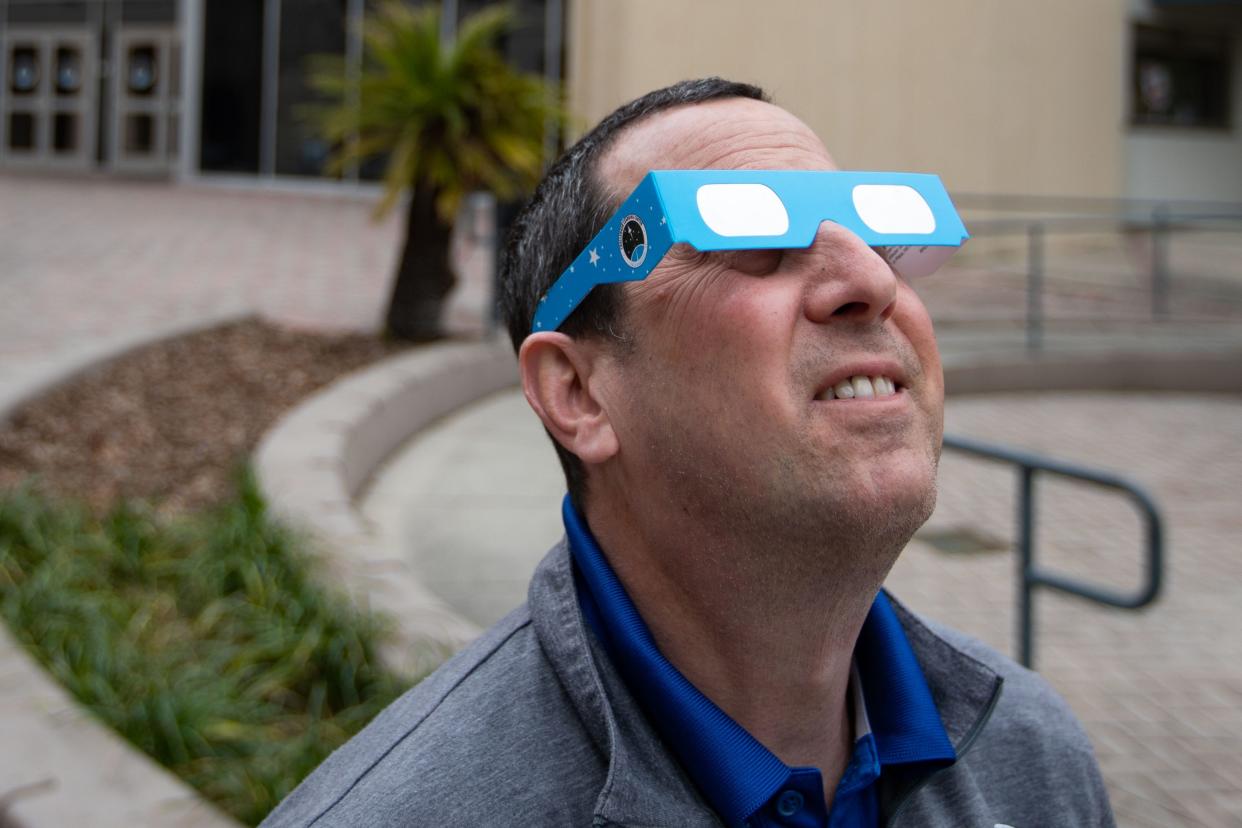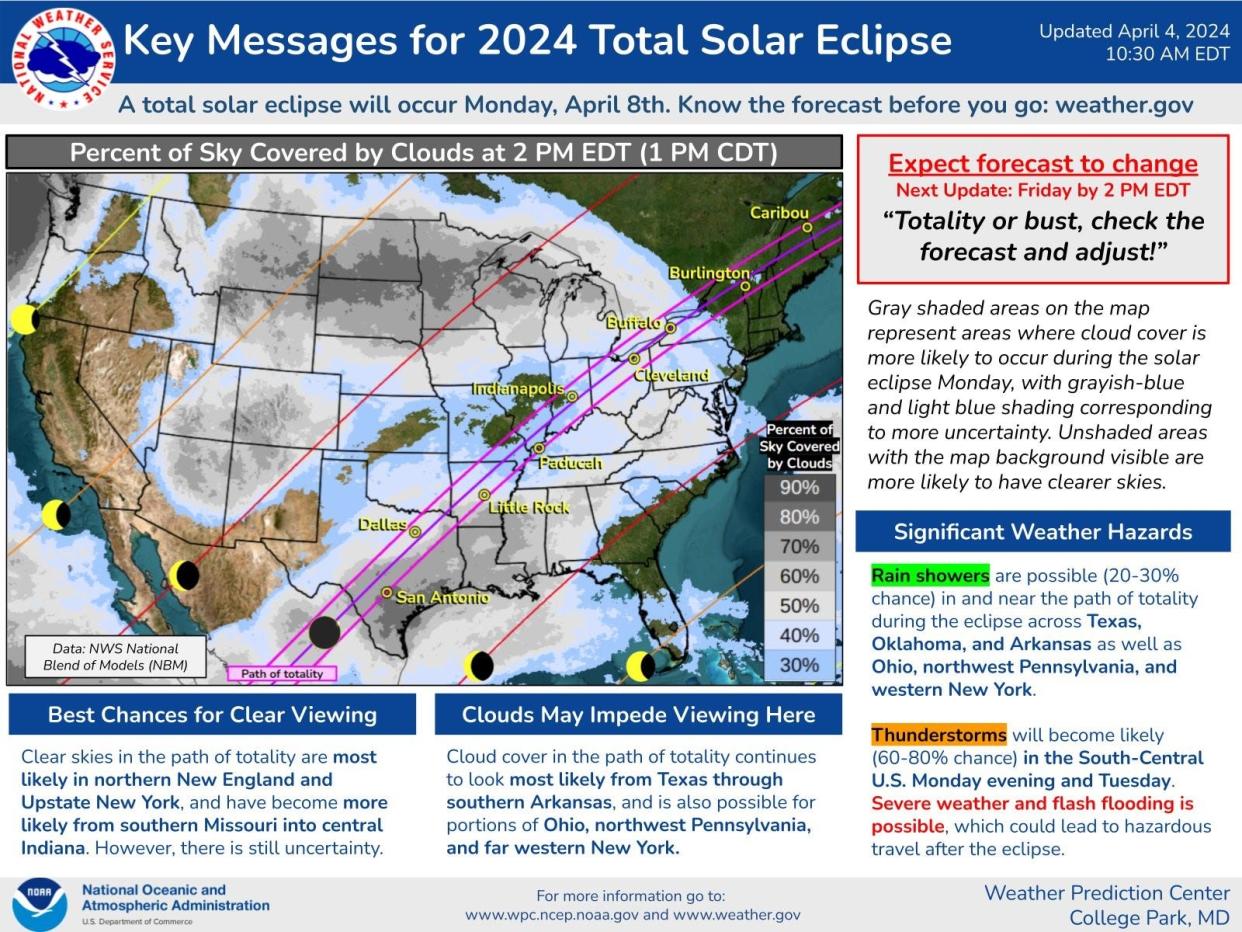Earth, moon and sun: Ultimate trio, and an ultimate guide to the eclipse in Tallahassee

Everyone is on standby for the cosmic shade that will be eclipsing all other events on Monday, April 8: The Great North American Eclipse.
The temporary fadeout will span across the North American continent with totality in 10 states, but Florida and Tallahassee will only get a partial view of the astronomical phenomenon.
Viewers in the North Florida region will see 71% of a total eclipse, which Alan Hanstein, executive director of the Challenger Learning Center, says is still a "real treat."
The Challenger Learning Center will be hosting a viewing event in Kleman Plaza with a live stream of the celestial event playing inside the planetarium, and telescopes will be set up by the Tallahassee Astronomical Society for an outdoor watch party.
There will also be hands-on activities in the exhibit hall for children and families. Solar glasses will be sold for $2.
Tallahassee Community College will be hosting a watch party at 2:45 p.m. on its intramural fields with solar glasses available to all. The event is open to the public.
Will school be in session?
Even though the sun will be hitting snooze for the eclipse vibes Monday, school in Leon County will still be in session.
Most public school teachers are turning the shady situation into an astronomy lesson for students so they don't miss out.
At Cobb Middle School, teachers will give their students solar glasses and take them outside during the time of the eclipse. They will also complete an interactive worksheet on the eclipse to stay engaged as it occurs.
What will the solar eclipse look like in Florida?

What's the weather going to be?
The forecast from the federal government's Climate Prediction Center for April 8 calls for "widespread cloudiness and precipitation for much of the eastern half of the nation," center meteorologist Anthony Artusa said. "This, of course, is not favorable for good viewing conditions near the path of totality."
The Weather Channel's long-range forecast is calling for a beautiful spring day with temps almost cracking 80 degrees. Forecasters say to expect sunny skies with only a 4% chance of rain.
The National Weather Service-Tallahassee told the Tallahassee Democrat on Wednesday that the weather would be cloudy skies on the day of the eclipse – but it's still uncertain how much that would impair visibility.
"We're watching for potentially thick clouds coming in from the west but we're still unsure how thick they're going to be and if they will totally limit viewing," said Wright Dobbs, a meteorologist with NWS Tallahassee.
In an updated forecast released on social media by the NWS, Tallahassee is predicted to catch 30% of cloud coverage Monday.
According to timeanddate.com, the partial eclipse will last for about two and a half hours in Tallahassee, starting at about 1:42 p.m. and ending at about 4:17 p.m., with maximum viewing at 3 p.m.
Countdown clock to 2024 solar eclipse
How much of the solar eclipse will be visible in Florida?
Florida is not in the path of totality for April's solar eclipse, meaning the moon won't totally block the sun.
Depending on where you are in the Sunshine State, the moon will block anywhere from 54-82% of the sun. Residents in the northwest corner of the state will see more of the eclipse.
In Tallahassee, experts say the capital city should catch at least 70% visibility of the celestial alignment.
➤ See exact times to go outside to see the eclipse across Florida
Path of 2024 total solar eclipse
The path of totality for April's solar eclipse stretches from northern Mexico to southeastern Canada before moving over the Atlantic Ocean. In the United States, the total solar eclipse will cross 13 states.
Texas, Oklahoma, Arkansas, Missouri, Illinois, Kentucky, Indiana, Ohio, Pennsylvania, New York, Vermont, New Hampshire and Maine, plus parts of Tennessee and Michigan, are all in the 115-mile-wide path of totality.
To see the exact path of totality, check out an interactive map created by French eclipse expert Xavier Jubier.
Don't turn a blind eye, wear solar glasses!
It's important to emphasize: Do not look directly at the sun, even during an eclipse. You can seriously damage your eyes. There might still time to get a pair of solar glasses or make a pinhole projector.
Also, be sure to watch out for fake eclipse glasses. They're dangerous.
When in doubt, buyers should refer back to the list of official sellers and manufacturers maintained by the American Astronomical Society, which communicates directly with sellers and manufacturers and checks test reports. Manufacturers need to have their glasses tested independently at two top labs in the U.S. to secure a spot.
For those who don't have solar glasses, there are alternative options for viewing the eclipse.
Casting a shadow on the ground using a pen and punching a hole through a sheet of paper or using a colander works just as well as any pair of glasses. The AAS site offers helpful instructions.
ICYMI: No worries! You'll only have to wait another 21 years
Tallahassee may not catch a full view of the total solar eclipse in April, but in about 28 years the city will have the distinction of becoming a solar eclipse capital of the United States.
Florida's capital will have seen totality in four solar eclipses between 1918 and 2052, setting a major astronomical record and making it one of the most eclipsed cities across the contiguous U.S., according to the Washington Post.
On average, a total solar eclipse only occurs in the same location once every 375 years, according to USA TODAY, which makes Florida's capital an outlier for the ages.
In an exclusive and rare occurrence of a 200-year period, Tallahassee has seen the sun fully go dark in 1918 and 1970, and will again in 2045 and 2052.
The 2045 path of totality will cross Alabama, Arkansas, northern California, Colorado, Florida, Georgia, Kansas, Louisiana, Mississippi, Missouri, Nevada, New Mexico, Oklahoma, Texas and Utah.
In 2052, the only states to be in the path of totality will be the southwest Georgia and the Florida panhandle.
Circling back to an eclipsed past
The last eclipse in Tallahassee was in October 2023, the Great American Eclipse, or the "ring of fire" annular solar eclipse.
An annular solar eclipse happens when the moon passes between the Earth and the sun while at its farthest point from Earth. So, the moon won't totally block the sun but leave a "ring of fire" visible around the moon.
Floridians were outside of the path of annularity for that celestial event and caught about 70% visibility of the eclipse, not to mention the weather was cloudy and many didn't catch a view.
In 2017, thousands of all ages gathered at the Challenger Learning Center's viewing party at Kleman Plaza to witness the brief but historical solar eclipse to witness 86% coverage of the sun.
In 1970, the total eclipse traveled a path from Central America up the east coast of the U.S. – with the nearby city of Perry anointed the first city in the U.S. to view the eclipse.
A crowd estimated at between 30,000 people and 50,000 people flocked to the small paper mill town, southeast of Tallahassee, which Florida Gov. Claude Kirk officially proclaimed as the “Eclipse Capital of the World” due to its early status and a heightened chance for favorable viewing weather.
But Mother Nature thwarted the eclipse tourism when the "city fell victim to a thick layer of clouds," the Democrat reported on its front page.
Fingers crossed: Tallahassee will get lucky with a glowing view of the breathtaking celestial event.
Alaijah Brown can be reached at ABrown1@gannett.com.
This article originally appeared on Tallahassee Democrat: The ultimate guide for the solar eclipse in Tallahassee
